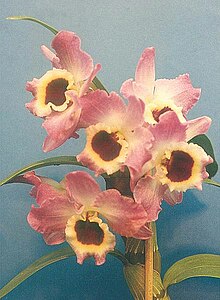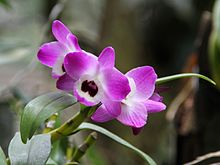Dendrobium nobile
This article needs additional citations for verification. (April 2010) |
| Dendrobium nobile | |
|---|---|

| |
| Scientific classification | |
| Kingdom: | |
| (unranked): | |
| (unranked): | |
| Order: | |
| Family: | |
| Subfamily: | |
| Tribe: | |
| Subtribe: | |
| Genus: | |
| Species: | D. nobile
|
| Binomial name | |
| Dendrobium nobile | |
| Synonyms[2] | |
| |
The Noble Dendrobium, Dendrobium nobile, is a member of the family Orchidaceae. It has become a popular cultivated decorative house plant, because it produces colourful blooms in winter and spring, at a time when little else is in flower. It is also one of the 50 fundamental herbs used in traditional Chinese medicine, known as shí hú (Chinese: 石斛) or shí hú lán (Chinese: 石斛兰). Dendrobium nobile is one of the most widespread ornamental members of the orchid family. Its blooms are variegated in colour, shading from white through pink and purple, and the many different cultivated varieties produce different sized and coloured blooms.
Dendrobium nobile is an epiphytic or lithophytic plant native to southern China (including Tibet), the Himalayas (India, Bangladesh, Assam, Nepal, Sikkim, Bhutan), and Indochina (Myanmar, Thailand, Laos, Vietnam).[2][3][4][5][6][7][8] The species is also reportedly naturalized in Hawaii.[9] It is the National flower of Sikkim respectively.
Dendrobium nobile occurs in lowland and mountain forests, often on mossy limestone rocks. It has strap-shaped, persistent leaves, and blooms mostly in winter and spring. It produces short, 2 to 4 flowered racemes, fragrant, waxy, and highly variable in color, arising from the upper nodes of leafed and leafless canes.
Examples of the species are grown in Kew Gardens Tropical Nursery in London and seeds are stored in the Millennium Seed Bank there.
Characteristics

Dendrobium nobile is a sympodial orchid which forms pseudobulbs. When the life cycle of the mother plant ends it produces little offsets, continuing the life of the plant. The new plant then goes through the same cycle. The stem is erect and during the flowering period blooms form along the whole length of the stem. This seed contains is monocot that is it forms only a single leaf, and the plant has thin white roots which attach themselves to another plant or object making it an epiphytic plant.
Chemical constituents
Extract of the stems of Dendrobium nobile yielded 17 phenanthrenes (including 3,4,8-trimethoxyphenanthrene-2,5-diol, 2,8-dihydroxy-3,4,7-trimethoxyphenanthrene, 3-hydroxy-2,4,7-trimethoxy-9,10-dihydrophenanthrene, 2,8-dihydroxy-3,4,7-trimethoxy-9,10-dihydrophenanthrene, 2-hydroxy-4,7-dimethoxy-9,10-dihydrophenanthrene, 2,2'-dihydroxy-3,3',4,4',7,7'-hexamethoxy-9,9',10,10'-tetrahydro-1,1'-biphenanthrene and 2,3,5-trihydroxy-4,9-dimethoxyphenanthrene).[10][11] There have been many studies on the complex chemistry of the plant.[vague]
Toxicity
Dendrobium nobile has been added to the EU novel foods catalogue as it is deemed unsafe for human consumption within food supplements without a safety assessment.[12]
See also
- Dendrobine, a toxin found in Dendrobium nobile
References
- ^ "Dendrobium nobile". Germplasm Resources Information Network. Agricultural Research Service, United States Department of Agriculture. Retrieved 2008-02-05.
- ^ a b Kew World Checklist of Selected Plant Families
- ^ Flora of China v 25 p 381, 石斛 shi hu, Dendrobium nobile Lindley, Gen. Sp. Orchid. Pl. 79. 1830.
- ^ Wood, H.P. (2006). The Dendrobiums: 1-847. A.R.G. Gantner Verlag K.G., Ruggell.
- ^ Lucksom, S.Z. (2007). The orchids of Sikkim and North East Himalaya: 1-984. S.Z.Lucksom, India.
- ^ Huda, M.K. (2007). An updated enumeration of the family Orchidaceae from Bangladesh. The Journal of the Orchid Society of India 21: 35-49.
- ^ Raskoti, B.B. (2009). The Orchids of Nepal: 1-252. Bhakta Bahadur Raskoti and Rita Ale.
- ^ Choudhary, R.K., Srivastava, R.C., Das, A.K. & Lee, J. (2012). Floristic diversity assessment and vegetation analysis of Upper Siang district of eastern Himalaya in North East India. Korean Journal of Plant Taxonomy 42: 222-246.
- ^ Ackerman, J.D. (2012). Orchids gone wild. Discovering naturalized orchids in Hawaii. Orchids; the Magazine of the American Orchid Society 81: 88-93.
- ^ Hwang, Ji Sang; Lee, Seon A; Hong, Seong Su; Han, Xiang Hua; Lee, Chul; Kang, Shin Jung; Lee, Dongho; Kim, Youngsoo; Hong, Jin Tae; Lee, Mi Kyeong; Hwang, Bang Yeon (2010). "Phenanthrenes from Dendrobium nobile and their inhibition of the LPS-induced production of nitric oxide in macrophage RAW 264.7 cells". Bioorganic & Medicinal Chemistry Letters. 20 (12): 3785. doi:10.1016/j.bmcl.2010.04.054.
- ^ Yang, H; Sung, S. H; Kim, Y. C (2007). "Antifibrotic phenanthrenes of Dendrobium nobile stems". Journal of Natural Products. 70 (12): 1925–9. doi:10.1021/np070423f. PMID 18052323.
- ^ https://web.archive.org/web/20150402140708/http://ec.europa.eu/food/food/biotechnology/novelfood/nfnetweb/mod_search/index.cfm?seqfce=908&verify=&action=mod_search.details&fldProdNam=Dendrobium+nobile
External links
 Media related to Dendrobium nobile at Wikimedia Commons
Media related to Dendrobium nobile at Wikimedia Commons- Dendrobium nobile List of Chemicals (Dr. Duke's Databases)
- National orchid societies which give advice about the cultivation of Dendrobium nobile and other orchid species include:
